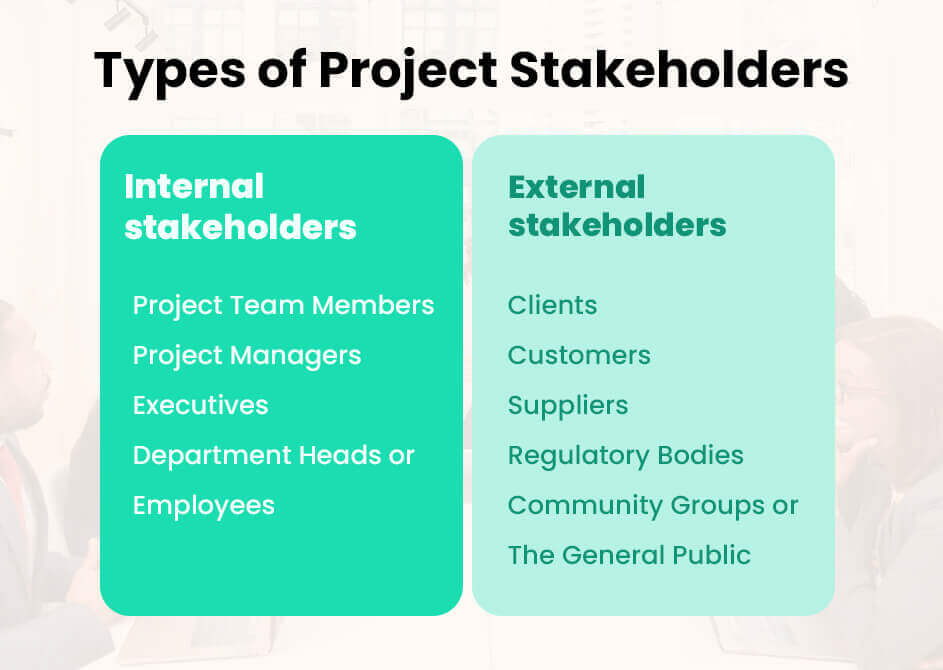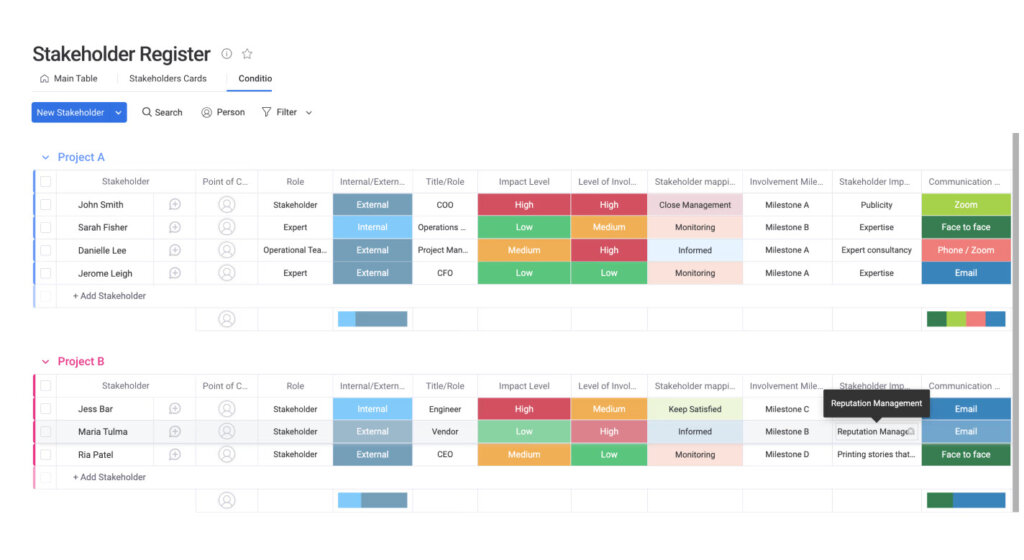A stakeholder register template is a document or tool used to capture and organize information about project stakeholders. It helps project managers and teams identify, analyze, and manage stakeholders throughout the project lifecycle. The template typically includes fields or sections to document essential details about stakeholders, such as their names, roles, interests, influence levels, communication preferences, and potential impact on the project.
The stakeholder register template serves as a central repository for stakeholder information, enabling project teams to understand the stakeholders’ needs, expectations, and potential risks or opportunities associated with their involvement in the project. It helps ensure effective stakeholder engagement, communication, and management.
Why is a Stakeholder Register Important?
Managing stakeholders effectively is crucial for the success of any project. Stakeholders can significantly influence project outcomes, and their interests and involvement must be carefully managed. This is where a stakeholder register comes in.
A stakeholder register is a comprehensive tool that helps project managers understand the various stakeholders, their priorities, and their potential impact on the project. It allows project teams to proactively engage with stakeholders, address their concerns, and align project objectives with their expectations.
By having a stakeholder register in place, project managers can identify potential risks and opportunities associated with stakeholder engagement. It helps in developing appropriate strategies and actions to manage these risks and leverage the opportunities to achieve project success.
What Information is Included in a Stakeholder Register?
Here are some common elements that a stakeholder register template may include:
- Stakeholder Name: The name or identification of the stakeholder.
- Stakeholder Role: The role that the stakeholder plays in the project, such as “project sponsor” or “end user.”
- Stakeholder category: Whether the stakeholder is internal or external to the organization, and whether they are a primary or secondary stakeholder.
- Contact Details: The stakeholder’s contact information, including email address, phone number, and any other relevant details for communication.
- Stakeholder interest: The level of interest that the stakeholder has in the project, such as “low,” “medium,” or “high.”
- Influence/Interest Level: A measure of the stakeholder’s influence on the project’s outcome and their level of interest in the project.
- Needs/Expectations: The specific needs, expectations, or requirements of the stakeholder regarding the project.
- Communication Preferences: The preferred communication methods and channels for each stakeholder.
- Potential Risks/Opportunities: Any potential risks, challenges, or constraints associated with stakeholder engagement that may impact the project’s success.
- Engagement Strategy: The approach or plan for engaging and involving the stakeholder in project activities.
- Action Items: Any specific actions or tasks assigned to the stakeholder or the project team regarding the stakeholder’s engagement.
- Communication and Engagement Plan: A plan that outlines how and when the project team will communicate and engage with stakeholders throughout the project’s duration.
- Status/Updates: The current status or updates related to the stakeholder’s involvement in the project.
Using a stakeholder register template helps project managers stay organized, identify key stakeholders, understand their needs, and develop appropriate strategies for managing their engagement throughout the project. It provides a structured framework for effective stakeholder management and communication, ultimately contributing to project success.

How to Create a Stakeholder Register?
Creating a stakeholder register involves several steps, including:
- Identify Stakeholders: Start by identifying all potential stakeholders who might have an interest in or be affected by the project. This includes both internal and external stakeholders.
- Classify Stakeholders: Once you have identified the stakeholders, classify them based on their interests, impact, and level of influence on the project. This classification will help in prioritizing stakeholders and tailoring the engagement approach accordingly.
- Gather Stakeholder Information: Contact and communicate with stakeholders to gather the relevant information needed for the stakeholder register. This may involve conducting interviews, surveys, or meetings to understand their expectations, concerns, and requirements.
- Record Stakeholder Information: After gathering the necessary information, record and document it in the stakeholder register. Ensure that the register is organized and easy to navigate to facilitate quick reference and updates.
- Create a Communication and Engagement Plan: Develop a communication and engagement plan that outlines how and when you will communicate with stakeholders. This plan should consider the stakeholders’ preferences and communication channels, as well as set clear expectations for engagement throughout the project’s lifecycle.
- Regularly Review and Update: A stakeholder register is a living document that should be reviewed and updated regularly throughout the project. As stakeholders’ interests, influence, or requirements change, make sure the register reflects those changes to maintain its accuracy and relevancy.
By following these steps, project managers can ensure that the stakeholder register is comprehensive, up-to-date, and aligned with the project’s objectives.
Benefits of a digital stakeholder register template
A digital stakeholder register template offers several benefits over traditional paper-based or manual methods. Here are some advantages of using a digital stakeholder register template:
- Enhanced Organization: Digital templates provide a structured and organized format to capture and store stakeholder information. It allows for easy sorting, filtering, and searching, making it convenient to locate specific stakeholders or retrieve relevant details.
- Improved Accessibility: Digital templates can be accessed and updated from anywhere, facilitating collaboration among team members, even when they are geographically dispersed. Stakeholder information is readily available to the project team whenever they need it, promoting efficiency and timely decision-making.
- Real-Time Updates: With a digital template, stakeholders’ information can be updated in real-time, ensuring the register remains current and accurate. This eliminates the need for manual updates or dealing with outdated versions of the stakeholder register, reducing the risk of miscommunication or oversight.
- Data Analysis and Reporting: Digital stakeholder registers often include features for data analysis and reporting. Project managers can generate reports, charts, or visualizations to gain insights into stakeholder engagement, influence levels, or other relevant metrics. This data-driven approach helps in identifying trends, addressing issues, and making informed decisions regarding stakeholder management.
- Integration with Collaboration Tools: Digital stakeholder register templates can integrate with other collaboration tools, project management software, or communication platforms. This integration streamlines the workflow, allowing seamless sharing of stakeholder information, task assignments, and updates across various project management systems.
- Security and Data Protection: Digital templates can offer secure access controls and encryption features to protect sensitive stakeholder information. User permissions can be set to restrict access to authorized individuals, ensuring the confidentiality and integrity of the data.
- Time and Resource Savings: Using a digital template automates repetitive tasks, such as data entry or formatting, saving time and reducing the likelihood of errors. It eliminates the need for printing, storing physical documents, and manually organizing paperwork, leading to improved productivity and cost savings.
Overall, a digital stakeholder register template streamlines stakeholder management processes, enhances collaboration, and provides valuable insights for effective project decision-making. It simplifies the management of stakeholder information, making it a valuable tool for project teams seeking efficient and organized stakeholder engagement.

What are some good apps for keeping track of the stakeholder data?
Here are some popular apps that can help you maintain a stakeholder register:
- Microsoft Excel: Excel is a versatile tool that can be used to create and manage a stakeholder register. You can customize the columns, track stakeholder details, and easily sort and filter the information as needed.
- Google Sheets: Similar to Excel, Google Sheets offers collaborative features, allowing multiple team members to access and update the stakeholder register simultaneously. It provides cloud storage and can be accessed from anywhere with an internet connection.
- Airtable: Airtable is a flexible and collaborative database tool that can be customized to create a stakeholder register. It offers various field types, including text, attachments, check boxes, and more, to capture and organize stakeholder information effectively.
- Trello: While primarily known for project management, Trello can also be used to maintain a stakeholder register. You can create cards for each stakeholder and add details such as contact information, roles, and engagement levels. Trello’s visual boards make it easy to track and manage stakeholders.
- Monday.com: Monday.com is a versatile project management tool that allows you to create custom boards to manage stakeholder information. You can track stakeholder details, assign tasks, set deadlines, and collaborate with team members, all within one platform.
- Notion: Notion is a comprehensive workspace tool that can be used to maintain a stakeholder register. It offers flexible templates and database features, allowing you to create a customized stakeholder register with rich media, attachments, and real-time collaboration.
- Salesforce: Salesforce is a robust customer relationship management (CRM) platform that can be utilized to maintain a stakeholder register. It offers advanced features for tracking stakeholder interactions, managing relationships, and generating reports for analysis.
Remember to assess your specific requirements, budget, and team preferences when choosing an app for maintaining a stakeholder register. Each app offers unique features and benefits, so consider the ones that align best with your project and team needs.
The Final Thoughts
A stakeholder register plays a crucial role in managing stakeholder engagement throughout the project’s lifecycle. By creating and maintaining a stakeholder register, project managers can effectively identify, analyze, and engage with stakeholders to ensure their needs and expectations are met. The stakeholder register provides invaluable insights into who the stakeholders are, how they can influence the project’s success, and how to effectively communicate and engage with them.
In a nutshell, the stakeholder register serves as a strategic tool that helps project teams build strong relationships with stakeholders, mitigate risks, and leverage opportunities. By continuously updating and utilizing the stakeholder register, project managers can foster a collaborative project environment and increase the likelihood of project success.
Remember, a stakeholder register is not a one-time process but a continuous activity that should be integrated into the project management framework. Regularly reviewing and updating the register enhances its effectiveness and ensures that stakeholders are involved and engaged throughout the project’s lifecycle.
#StakeholderManagement #ProjectSuccess #EngagingStakeholders #EffectiveCommunication #StakeholderEngagement #ProjectManagement #StakeholderRelations #StakeholderNeeds #ProjectLeadership #StakeholderCollaboration #ProjectPlanning #StakeholderSatisfaction #StakeholderInfluence #ProjectEngagement #StakeholderAlignment #ProjectDelivery #StakeholderRegisterTemplate #EffectiveProjectManagement #StakeholderEngagement #ProjectSuccess #StakeholderAnalysis #Communication #RelationshipManagement #Transparency #ProjectManagementToolkit
